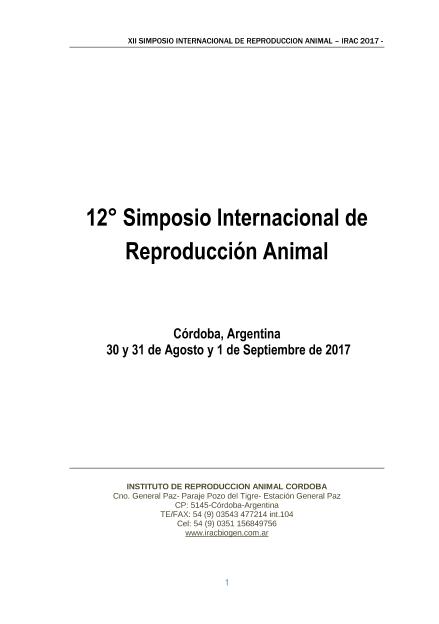Mostrar el registro sencillo del ítem
dc.contributor.author
Tapia, Carla
dc.contributor.author
Bianchi, Carolina Paula

dc.contributor.author
Rodríguez Pérsico, Juan Manuel
dc.contributor.author
Raggio, Santiago
dc.contributor.author
Beltramo, Maximiliano
dc.contributor.author
Bo, Gabriel Amilcar

dc.contributor.author
Anduaga Marchetti, Iván Alfredo

dc.date.available
2022-12-27T10:23:08Z
dc.date.issued
2017
dc.identifier.citation
Quantification of plasma progesterone (P4) in cattle using the ELFA technique; 12° Simposio Internacional de Reproducción Animal; Córdoba; Argentina; 2017; 1-5
dc.identifier.isbn
978-987-4428-00-4
dc.identifier.uri
http://hdl.handle.net/11336/182418
dc.description.abstract
The quantification of hormones involved in the bovine reproductive cycle is important for assessing and diagnosing the reproductive status of the animal. Different clinical interpretations can be done with the determination of progesterone (P4) levels, and values below 1 ng/ml indicate absence of corpus luteum. Furthermore, recent publications have shown that values below 2,7 ng/ml on day 7 or 5 ng/ml on day 14 of the cycle could predict pregnancy loss. Currently, the gold standard technique to measure circulating P4 levels isradioimmunoassay (RIA). However, simpler and more accessible diagnostic techniques are now emerging. The purpose of this study is to evaluate a new commercial in vitro diagnostic assay of P4 based on enzyme immunoassay by competition with detection of final fluorescence (ELFA). A total of 67 blood samples, from 25 cows, were collected using BD Vacutainer (BD, USA) with sodium heparin by jugular venipuncture at different days of estrus cycle, and centrifuged at 3000X g for 30 min for plasma separation, which were frozenat -20 °C until analysis. P4 levels were measured in duplicate for both techniques: IM1188-PROGESTERONE-RIA (Beckman Coulter, USA) and VIDAS-PRG-ELFA (Biomerieux,France). P4 levels obtained by RIA were classified in two groups as A) P4 <1ng/ml and B) P4≥1ng/ml and matched with P4 values obtained by ELFA. Kappa test was used to determine agreetment between both techniques, coeffiecients of intra-assay variation were determined for RIA and ELFA and sensibility (Se); specificity (Sp); positive predictive value (PPV) andnegative predictive value (NPV) were determined for ELFA technique. There is a very good agreement between the RIA and ELFA techniques Kappa=0.96 to determine P4 levels for group A (48 and 47 samples, respectively) and group B (19 and 20 samples, respectively).The coefficients of intra-assay variation were 5% and 2.9% for RIA and ELFA respectively. The Se=1; Sp=0.97; PPV=0.95 and NPV=1 were obtained for ELFA. In conclusion, only one sample differed its value between the two techniques, representing 1.49% of difference. These results demonstrate that quantification of bovine plasma P4 can be performed with ELFA with similar reliability as the RIA technique. This commercial assay allows measuring P4 levels in the cattle in an easy and applicable way to the daily routine. Further studies should be carried out to strengthen these conclusions.
dc.format
application/pdf
dc.language.iso
eng
dc.publisher
Instituto de Reproducción Animal
dc.rights
info:eu-repo/semantics/openAccess
dc.rights.uri
https://creativecommons.org/licenses/by-nc-sa/2.5/ar/
dc.subject
PROGESTERONE
dc.subject
PLASMA
dc.subject
BOVINE
dc.subject
ELFA
dc.subject.classification
Ciencias Veterinarias

dc.subject.classification
Ciencias Veterinarias

dc.subject.classification
CIENCIAS AGRÍCOLAS

dc.title
Quantification of plasma progesterone (P4) in cattle using the ELFA technique
dc.type
info:eu-repo/semantics/publishedVersion
dc.type
info:eu-repo/semantics/conferenceObject
dc.type
info:ar-repo/semantics/documento de conferencia
dc.date.updated
2022-11-09T18:35:19Z
dc.journal.pagination
1-5
dc.journal.pais
Argentina

dc.journal.ciudad
Córdoba
dc.description.fil
Fil: Tapia, Carla. No especifíca;
dc.description.fil
Fil: Bianchi, Carolina Paula. Consejo Nacional de Investigaciones Científicas y Técnicas. Centro Científico Tecnológico Conicet - Tandil. Centro de Investigación Veterinaria de Tandil. Universidad Nacional del Centro de la Provincia de Buenos Aires. Centro de Investigación Veterinaria de Tandil. Provincia de Buenos Aires. Gobernación. Comision de Investigaciones Científicas. Centro de Investigación Veterinaria de Tandil; Argentina
dc.description.fil
Fil: Rodríguez Pérsico, Juan Manuel. Biogenesis Bago S.a..; Argentina
dc.description.fil
Fil: Raggio, Santiago. Biogenesis Bago S.a..; Argentina
dc.description.fil
Fil: Beltramo, Maximiliano. No especifíca;
dc.description.fil
Fil: Bo, Gabriel Amilcar. No especifíca;
dc.description.fil
Fil: Anduaga Marchetti, Iván Alfredo. No especifíca;
dc.relation.alternativeid
info:eu-repo/semantics/altIdentifier/url/https://iracbiogen.com/wp-content/uploads/2021/06/RESUMEN-12-Simposio-Internacional-de-Reproduccion-Animal-20170.pdf
dc.conicet.rol
Autor

dc.conicet.rol
Autor

dc.conicet.rol
Autor

dc.conicet.rol
Autor

dc.conicet.rol
Autor

dc.conicet.rol
Autor

dc.conicet.rol
Autor

dc.coverage
Internacional
dc.type.subtype
Simposio
dc.description.nombreEvento
12° Simposio Internacional de Reproducción Animal
dc.date.evento
2017-08-30
dc.description.ciudadEvento
Córdoba
dc.description.paisEvento
Argentina

dc.type.publicacion
Book
dc.description.institucionOrganizadora
Instituto de Reproducción Animal
dc.source.libro
12° Simposio Internacional de Reproducción Animal
dc.date.eventoHasta
2017-09-01
dc.type
Simposio
Archivos asociados
